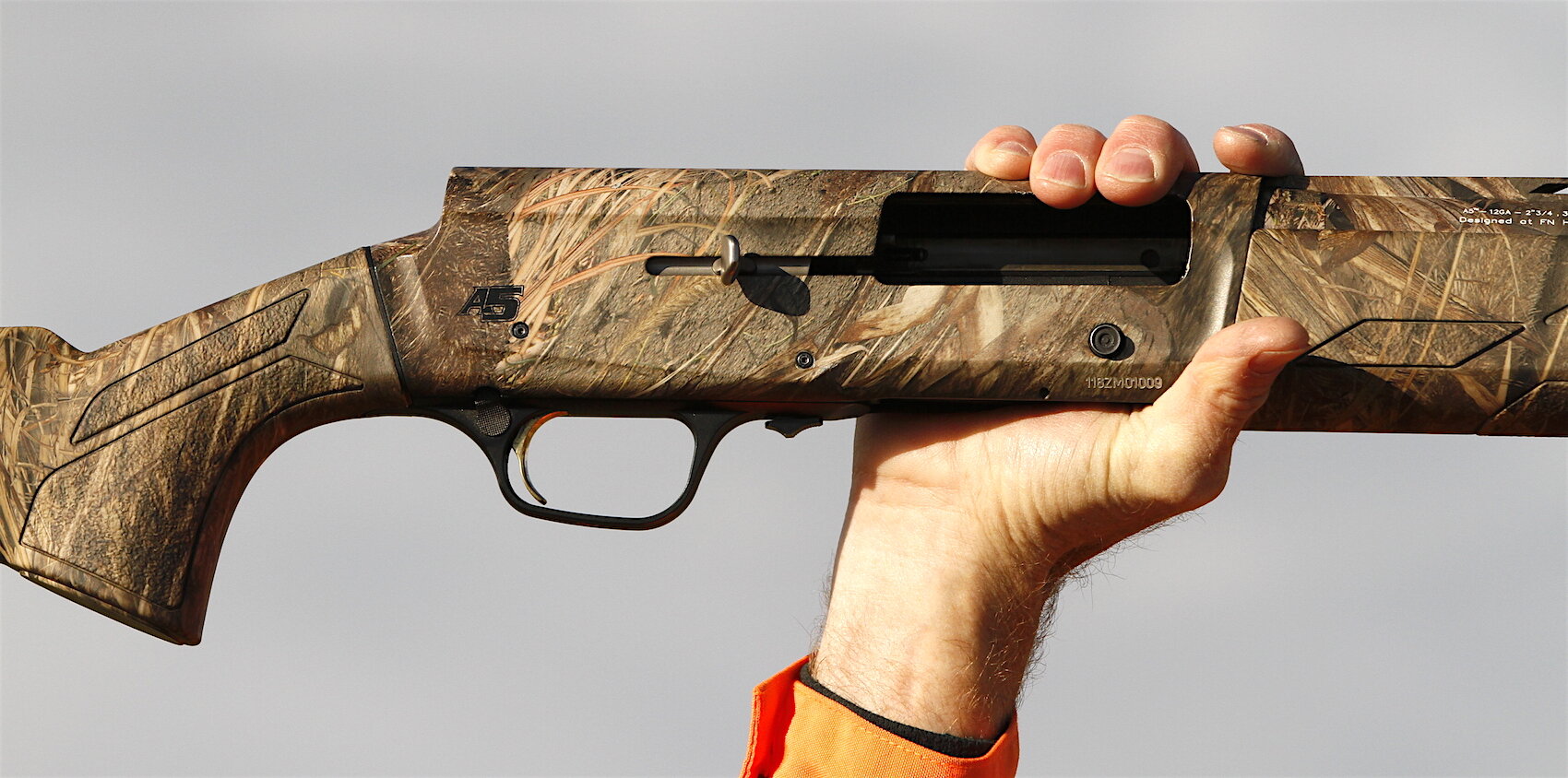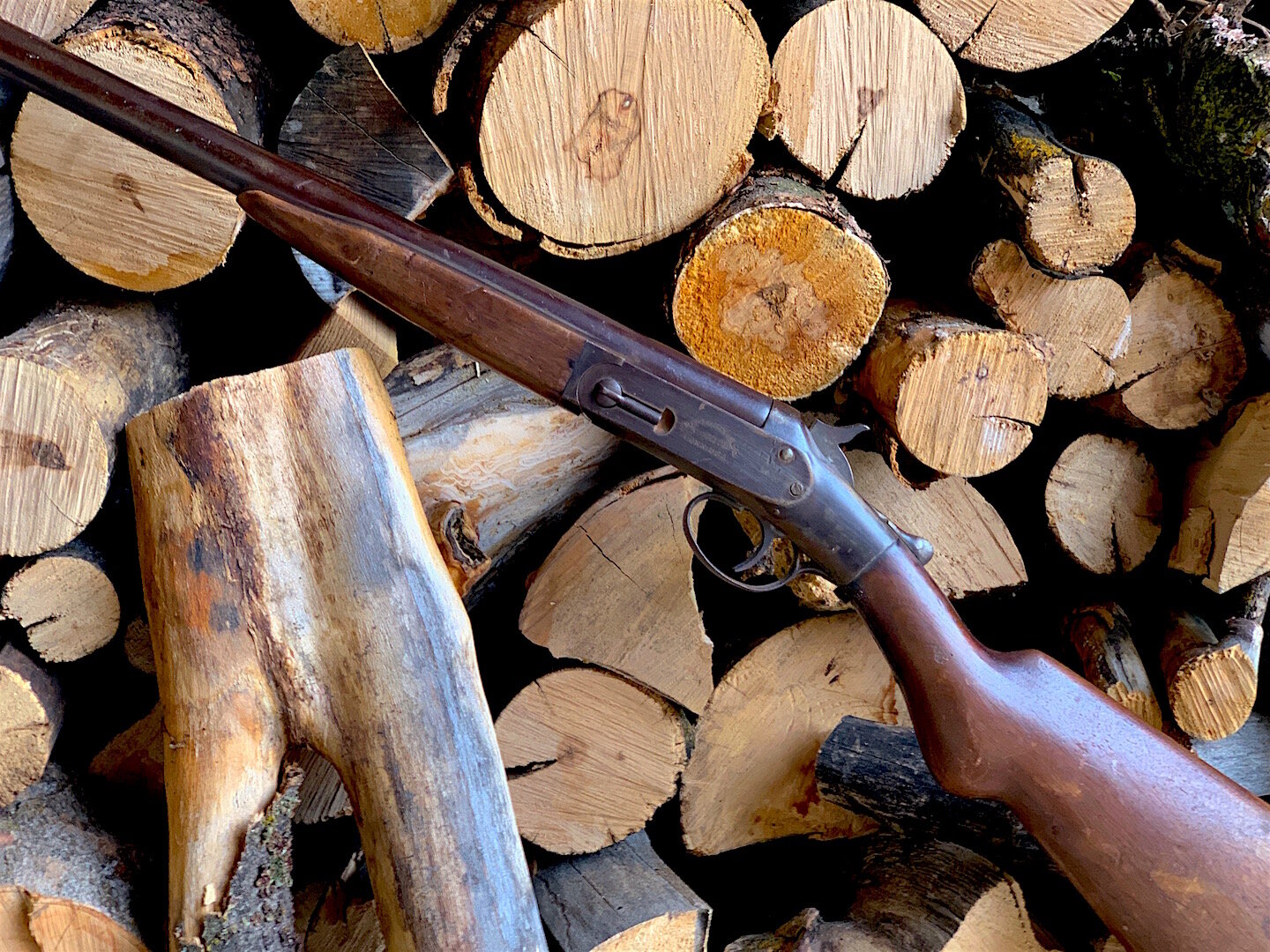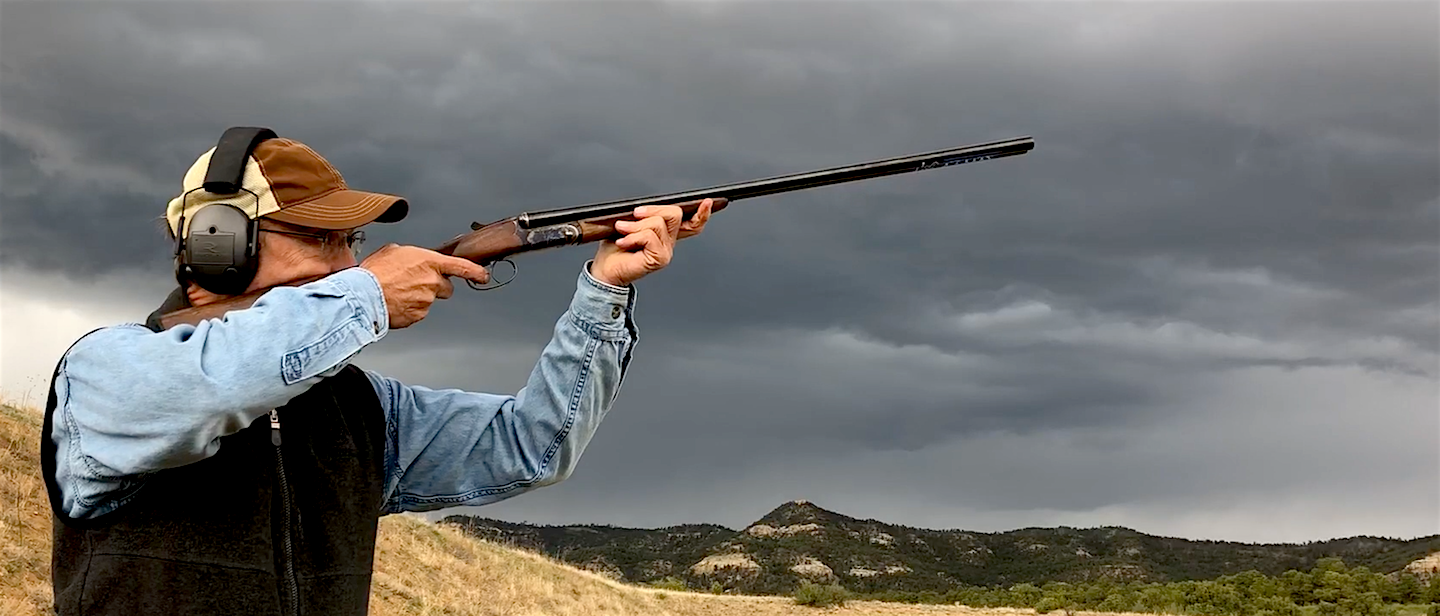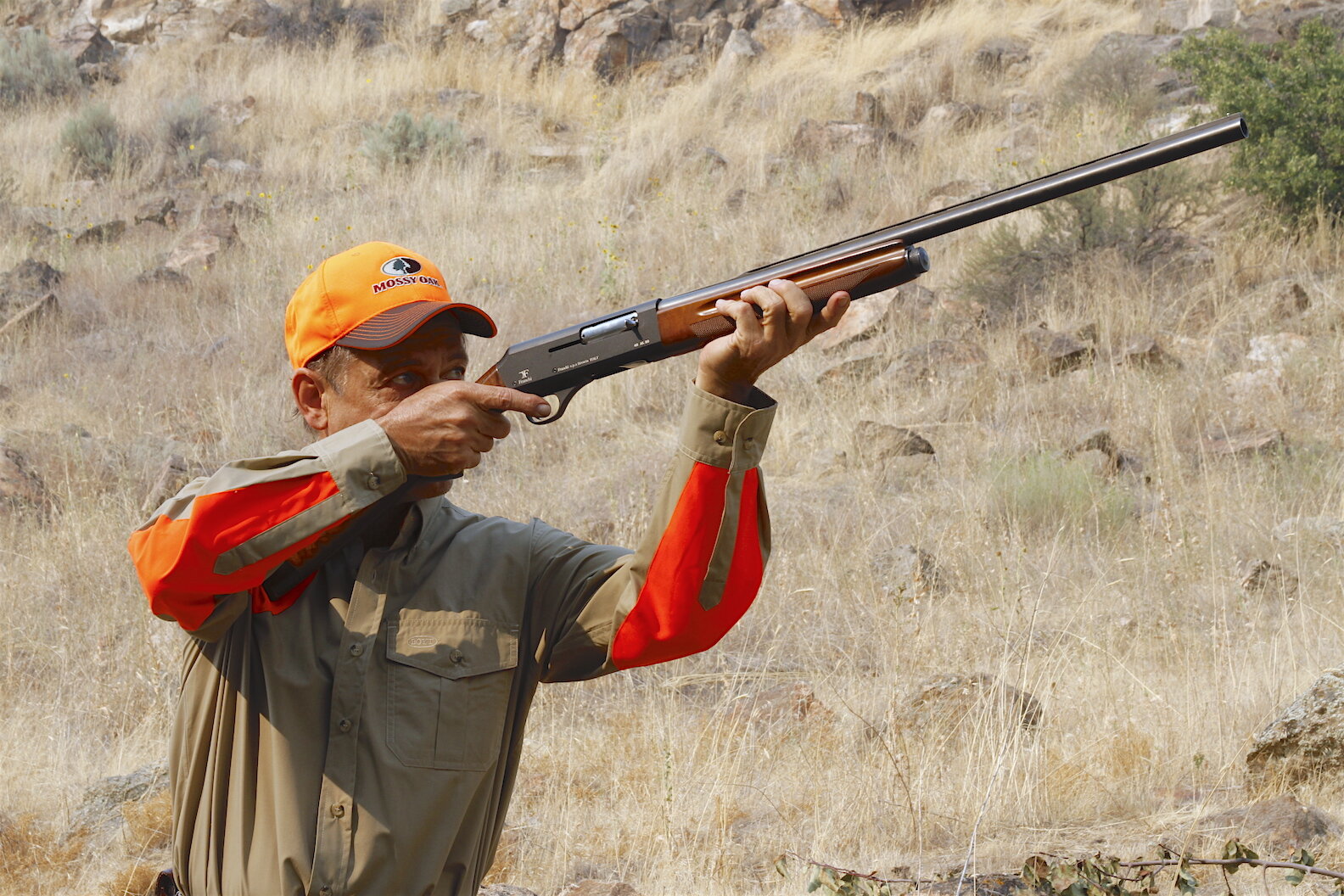Best Shotgun For You?
What’s the best shotgun for hunting? For you?
If you can't decide, welcome to another first world problem. Count your blessings. I think we can solve this welcomed challenge. Here are our common options: Break-action single shot. Break-action over/under. Break- action side-by-side. Pump-action. Autoloader.
Image shows rack of new shotguns.
What's the best shotgun for you? Welcome to the first-world luxury of getting to decide. Here is a rack of
and
to get you started.
Which of the five should you choose? The answer is YES.
I don’t wish to be facetious, but, truly, all these action typeswork quite well. You really can’t go wrong as long as you like whichever youchoose and the gun fits you. Most importantly the gun must fit you. Why?Because when you throw a shotgun to your shoulder, it should be pointing whereyou are looking. You don’t aim it. You just concentrate on the target and shootbecause with proper gun fit, the barrel will always be pointing where you arelooking. But gun fit is a topic for another article. For now, let’s examine thepros and cons of these action styles.
Break-Action Single Shot
Image show rough, old single-shot break action shotgun.
The cheap, basic break-action single-shot was a common farm tool through the first half of the 20th century. Modern version are much safer. One that fits the shooter can be just as effective as any other shotgun action. Just one shot at a time.
With the exception of some high dollar specialty trap guns, break-action single-shots are inexpensive, simple starter guns. Like many farm kids in the mid-20th century, I shot my first ducks and pheasants with a break-action single-shot in .410. It was Grandpa’s varmint gun on the farm. He kept it beside the kitchen door for easy access should a skunk, fox or coon come calling the chickens for a date.
The upside of these guns is they are simple and inexpensive. But they aren’t necessarily safe. Virtually all have an external hammer that must be pulled back to cock. he tension on some of these is quite heavy, leading to the distinct possibility a partially pulled hammer falling before it catches and locks back. The result is an "accidental" firing. Back in the day more than one kid did this. More modern iterations of these guns include a transfer bar safety that blocks the hammer from striking the primer until after it is fully cocked, but watch out for the older ones.
The stock lines of these single-shots – drop at comb and heel especially – are not the best, contributing to increased felt recoil and poor shooting. Recoil isn’t an issue with .410 and light 20-gauge loads, but have a knowledgeable shotgunner check fit. If you can get one of these to fit well, it will drop birds as effectively as most high-end guns. And the single-shot will tach new shooters (and even old) to make their shots count.
Is Over/Under Your Best Shotgun?
Image shows muzzles of o/u shotguns. Best shotgun could be over/under due to two barrels for instant selection and quick shots.
Over/Under shotguns offer two barrels for instant choke selection. Interchangeable choke tubes add even more versatility.
These classic break-actions are quite a bit fancier and more complex than the break-action single shots above. Sears, hammers, springs, etc. are neatly enclosed in the action and grip. No external hammers. There is a safety and usually a single trigger with a barrel selector atop the tang or on the side or back of the trigger. Over/unders are not cheap, although there are some models like the Mossberg Silver Reserve, CZ Redhead, and Savage/Stevens M555 with MSRP of $700 to $1,000. Over-Under shooters report they like the slim, single barrel shooting plane with the quick, two-shot, two choke option.
Mossberg's Silver Reserve over/under is on of the least expensive on the market and could be your best shotgun.
Your best shotgun could be an inexpensive over/under like this 20 ga.
retailing for well under $1,000.
I find O/Us easy to carry and swing into action, simple and fast to operate, and easy to transport. Because they quickly break down into three short pieces, you can put them in convenient, short cases that don't scream "long gun!"
Image shows highly engraved and gold inlaid Ceasar Geurini Revenant 20 ga., definitely a best shotgun for someone with lots of cash.
Or, if you prefer a slightly embellished over/under,
offers this Revenant 20 ga. for MSRP just under $13,000. I'm not selling anything here, just showing it off! But if you want to start a go fund me page to procure a Revenant for me, I won't argue.
Side-by-Side Ultimate Classic
Shuck the torn blue jeans and ragged flannel shirt. It’s time to play Mr. Orvis Tweed. Well, that’s the cache’ a SxS double carries in the eyes of many. It’s the snob appeal. The sporting gent’s shotgun. But you can ignore that because you don’t have to be a dandy dresser or a snob to appreciate a SxS. What you want one for is to enjoy shooting and perhaps shooting better while feeling somehow more virtuous. I kid you not. When I got my first cheap, rough side-by-side shotgun, my self-image climbed a few rungs up the sporting ladder, pulling my actual behavior up with it.. I thought I’d joined the pantheon of classic hunters and conservationists who’d stopped market hunting, established national wildlife refuges and started modern wildlife management. I thus began to conduct myself afield more as a gentleman and less as a “me first” country bumpkin meat hunter. I was less liable to hog all the shots or fall to the temptations of bending the rules. And, I started shooting better. Sounds crazy, but that’s how the human mind works. Or at least mine.
Image shows shooter swinging side-by-side double barrel FAIR shotgun illustrating inexpensive SxS.
Even a relatively inexpensive side-by-side like this box-lock 20 ga.
can make you a better shot and classier hunter. The key is to get a gun that feels good in your hands and aims where you look. This FAIR Iside did that for me. Note the double triggers. If one side should break, you're still in business with the other.
Aside from this psychological bump, side-by-sides do offer some shooting advantages, same as the over/unders. Two barrels, two chokes. Fastest two shots in the business. And get one with two mechanical triggers and you have useful redundancy. Should one trigger, sear, or striker/hammer fail, you have a complete set still functioning on the other side. Keep hunting.
You can get side-by-sides with wide “beavertail” forends or narrow “splinter” forends. Personal preference. You can get them weighing 6 pounds or 10. Fancy or plain. Sleek and smooth or boxy and clunky. They come in two basic action types, box and sidelock, but there’s no huge advantage to either. Just choose one that feels right in your hands and points where you look. Most SxS, like O/Us, are pricey, but there are a few in that $1,000 range. You might get lucky and find an old one – really old – still in good condition. U.S.-made SxSs from the early 20th century were high-quality and durable.
One advantage a SxS has over an O/U is reduced hinging. When youthrow the tang lever to open the gun, an O/U must hinge at a steep angle to exposethe bottom chamber. The SxS does not, since both barrels are on the same level.This can be an issue in the confines of a duck blind, but is generally not abig deal.
Photo shows a side-by-side broken open to load 20 ga. shell.
Side-by-side shotguns break open at a shallow angle to expose both chambers for quick and easy reloading and unloading. You can get models that eject empties or merely extract them part way.
Whether you choose SxS or O/U, decide if you want extractors or ejectors. I like extractors because they don’t fling empties far into the grass making me grovel and search so I don’t litter. Extractors leave the shell lifted from the chamber so I can pull it and save it for reloading. Of course, you can train yourself to place a palm over the breech to stop the flying shells from an ejector.
Pump Up Your Best Shotgun
Pumps are inexpensive, tough and durable, but many consider them the farm implements of shotguns because you see those action bars and hear them schlick shlack shells in and out. I rather like the sound myself. Reminds me that I’m doing something to help the cause. Rather like driving a stick shift instead of automatic.
Image shows an old Remington pump action in 16 gauge with pheasants.
Pump actions like this old Remington M31 16 ga. were extremely popular in the mid-20th century. They are still wonderfully effective and inexpensive, although pheasants don't much care for them.
Pumps were everyman’s shotgun throughout the 20th century, but have been superseded by autoloaders which are generally lighter recoiling. You can offset some of this by adding a bit of weight to the pump (recoil reducer tube in butt stock or a longer, thicker barrel.) Pumps are versatile because you can easily remove and replace barrels, switching from a 26”, fast-pointing barrel for tight-cover birds to a 28” or even 32” for pass shooting waterfowl. Most have interchangeable screw chokes these days, as do all other action types. But if you get on older barrel with fixed chokes, you can always add a second barrel inexpensively. You can even get a rifled slug barrel for deer hunting.
Pumps can eject from the side or bottom. Safeties are either atopthe tang or on the trigger guard, front or rear. I like the front of triggerguard because it lets me carry with my trigger finger outside the guard,protecting the trigger from limbs and sticks while keeping it on the safetybutton for quick activation.
Image shows hunter holding pump-action M870 shotgun and two partridge.
Beware the hunter with a well worn pump shotgun. He probably knows how to use it. This is the ubiquitous Remington M870 with its latest brace of gray partridge and an owner who probably thinks this is the best shotgun -- for him.
Pumps are ridiculously fast to operate once you’ve mastered them. I once shot three times at a SD rooster so fast that my buddy a short distance away though I’d shot just ounce. He might have been humoring me. Would have been better if I had gotten it on the first shot. Some pump shooters have won speed shooting contests against autoloaders. Of course, fast follow up shots aren’t as important as precise first shots, and pumps can easily be fitted (stocks bent, combs raised or lowered, etc.)
Last but not least, pumps can be wonderfully inexpensive. Some basic synthetic stock models retail for less than $300. H&R recently offered one for less than $200! When shopping pumps, look for ones with dual action arms, the metal bars running from the forend to the bolt.
You Auto Consider This
This is THE shotgun of the early 21st century. Manufacturers have ironed out most autoloader glitches and upped quality control. These soft-shooting guns are now considered as reliable as pumps. They recoil less than pumps or doubles because some of the recoil energy is absorbed by and spread over time by the action of the bolt or barrel.
Image shows Mossberg 930 autoloading shotgun beside snow-covered mallard and goose.
Thanks to recoil moderated by the cycling of its action, an autoloader like this
is the best shotgun for most waterfowlers these days. They need to shoot large payloads of large shot, and the 12 gauge does it best. A weatherproof finish like this atop a non-warping synthetic stock is a good idea, too. Those calls are a pair of famous custom
.
I’d choose an auto for waterfowl, turkeys, and deer shooting big, hard kicking loads. Those call for a fairly big, heavy gun, too, which isn’t best for upland birds. Most auto makers are putting R&D and marketing into reduced recoil features. Better butt pads, cheek pads, built-in recoil absorbers, etc. They put these features into lighter weight guns suitable for upland hunting as well as waterfowl. Only you can tell which really shoot with the least kick. Study the mechanics and marketing, but let your cheek and shoulder make the final decision.
With a lighter recoiling auto you should be able to recover andget back on target faster than with a pump because you don’t have to move thatleading hand to cycle the action. In theory. In practice, shooters learn topump impressively fast and smoothly, staying right in line with the barrel.
Fouling and gumming have long plagued autoloader function, butmost of today’s models can be shot dozens if not hundreds of times, reliably,without cleaning. Some are self-cleaning to a degree and can fire thousands ofshells without a hitch.
Photo shows Benelli Super Black Eagle 3 auto 12 ga. with barn pigeons.
Feral barn pigeons are good subjects on which to test drive any shogun in any season. This
seemed to handle the test. Note the shock absorbing rubber chevrons in the but stock. Much of autoloader design these days plays toward reducing felt recoil.
Other than using recoil action or gas to cycle the next round,autos are much like pumps. They can be built thick and clunky or delightfullyslim and handy. Regardless, I don’t think they ever quite match the slim, trim,quick, minimalist look, feel, and function of a fine double.
Fit Leads to Your Best Shotgun
Regardless which action type you buy, select a good one that fits and points right where you want your shot to strike. Test drive many if you can. How does the grip feel in your hand? Is the stock too long or short? Does the comb result in your eye being too far over to the right or left? Is the gun too muzzle heavy or light? You don’t want the balance toward the butt; the muzzle will wobble all over. A bit of weight out front helps keep on target and follow-through. Check all this stuff carefully. Shop and compare.
Photo shows shooter pointing a 20 ga. autoloading Franchi.
Regardless the action type, a shotgun must fit you, handle easily, and shoot where you look. This is a 20 ga. Franchi AL48, a near copy of John Browning's old Auto 5. It's been know to hit a partridge now and then.
With any action style, pay attention to whether it is built on a scaled action or not. Some manufacturers put 20 gauge barrels on 12 gauge actions. Cheaper to make, but the gun ends up being heavier and clunkier than it need be. A 20 or even 28 built on an action scaled to fit the smaller shells can be a work of art.
Best Gauge for Best Shotgun
Oh, one last thing. The 12 gauge is hands down the most versatile. Shells are usually cheapest, too. The 20 gauge is next. I’d go with it if I mostly hunted upland birds and small game. The 12 is much better for waterfowl because it handles large pellet sizes more efficiently. And you need larger pellets in steel waterfowl loads.
Image shows 28, 20, and 12 ga. shells.
Three of today's most popular shotgun shells are 28, 20, and 12. The black 12 is by far the most popular and versatile, but the yellow 20 ga. might be perfect for upland hunters. The slim, red 28 gauge is rather a specialists choice for upland birding hunting.
The 16 gauge is fun and a great balance between the 12 and 20, but shells are few and far between, although the selection is getting better. The 28 gauge is a specialty upland bird gun that shoots all out of proportion to its size. Get one if you love quail, grouse, and pheasant hunting. But you’ll be stuck with expensive lead shot shells and a few really expensive bismuth and reallyreally tungsten no-tox options. But for mild, sweet shooting, you can't beat a built-to-scale 28 gauge.
Spomer has been privileged to shoot and hunt with a wide variety of shotguns around the world. His favorite is whichever he has when the birds are flying -- but it must be nicely balanced and pointing where he's looking. "A clunky, unwieldy shotgun is almost as bad as no shotgun at all."
# # #

























